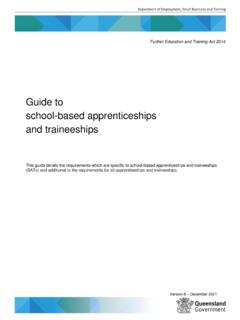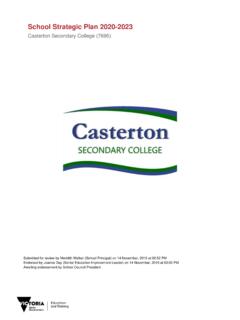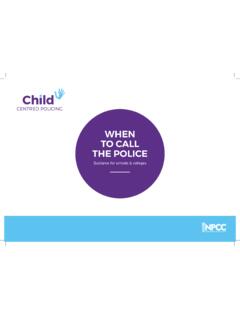Transcription of Teachers' Perceptions on Senior High School Readiness of ...
1 Universal Journal of Educational Research 4(10): 2447- 2462, 2016 DOI: Teachers' Perceptions on Senior High School Readiness of Higher Education Institutions in the Philippines Imee C. Acosta1,*, Alexander S. Acosta2 1 Department of Fashion & Graphic Design, Technological University of the Philippines, Philippines 2 Department of Administration, Technological University of the Philippine, Philippines Copyright 2016 by authors, all rights reserved. Authors agree that this article remains permanently open access under the terms of the Creative Commons Attribution License International License Abstract The focused of this study is on the Readiness of higher education institutions in the Philippines to the implementation of the Senior High School program of the new K-12 curriculum. Data were collected through a survey questionnaire.
2 The findings reveal five predisposing factors, namely: eligibility, staffing guidelines, course streamlining, workforce surplus management, and alternative programs to be determinants of Senior high School Readiness among college teachers and higher education institutions that will ensure sustainability and the promotion and protection of the welfare of the affected faculty and other employees in the higher education sector. Keywords K-12, Preparedness, Eligibility, Higher Education Institutions, Staffing Guidelines, Course Streamlining, Workforce Surplus Management 1. IntroductionIn the Philippines, one of the major thrusts of former President Benigno Aquino s government was the enhancement of the basic education program known as the Republic Act No. 10533 series 2012 which was signed into law on May 15, 2013.
3 The law was enacted and promulgated because the Philippines is the last country in Asia and one of only three countries worldwide with a 10-year pre-university cycle. This recent educational reform efforts instituted by the Philippine government intends to improve the quality of the high School graduates. These new graduates are envisage to become more competitive in the global business arena and to bring more success that would contribute towards building the nation and be at par with the rest of the world. The implementation of the universal kindergarten began in SY 2011-2012, followed by the new curriculum for Grade 7 in SY 2012-2013. This was primarily aimed to strengthen the Philippine basic education curriculum and increase the number of years of basic education [1,2]. The new program covers Kindergarten plus 12 years of basic education.
4 Under this program a student will be required to undergo kindergarten, six years of elementary, four years of junior high School and two years of Senior High School [3]. The additional two years in Senior high School was targeted to prepare students for tertiary education, middle level skills development, entrepreneurship, and global employment [4]. However, the full implementation of the K-12 program will be marked by the entry of the first batch of Senior high schools in June 2016. This would mean that there will be no college freshmen for SY 2016-2017 and SY 2017-2018 and no second year enrollees for SY 2017-2018 and SY 2018-2019. While there will already be college freshmen by 2018; there will be no third year college students for SY 2018-2019 and SY 2019-2020, and no fourth year college enrollees for SY 2019-2020 and SY 2020-2021 [5].
5 Colleges and Universities or the Higher Education Institutions (HEIs) are expecting a drop of enrollment during these five years until SY 2021-2022 when things are expected to normalize [6]. As the new college curriculum starts to roll in SY 2016-2017 most colleges and universities will be affected, not only by the drop of enrollment but also by the reduction of course offering and decrease in faculty workload. The workload of General Education college faculty members will be adversely affected because of the phasing out and/or realignment of courses since some of the college subjects are already transferred and taught in the Senior high School [7]. It can be construed from the above scenarios, that no new enrollees and reduction of workload for faculty, would mean loss of income for colleges and universities, decrease in faculty salaries, and possibly, not enough jobs for teachers.
6 Hence, creating a serious threat to the employment of college faculty and staff working in the higher education sector [2,6,8,9]. The Higher Education Institutions (HEIs), such as universities and colleges, are viewed as critical partners in implementing the K-12 education policy at the national level. With few months left before the K-12 program is in full swing, HEIs have been making preparations to ensure that their institution is ready for the transition period in 2016 where there will be no freshmen enrollees for two years. However, because of the growing concern of the 2448 Teachers' Perceptions on Senior High School Readiness of Higher Education Institutions in the Philippines downsizing impact brought about by the implementation of the new program; this study is geared towards assessing the Readiness of Colleges and Universities to bridge the gap brought about by the implementation of the Senior high School program.
7 The researcher finds it necessary to determine the required preparations to support the would-be affected faculty to serve as implications for alternative program initiatives to mitigate the negative impact of the nationwide implementation of the K-12 program. Constructively, the idea of embracing innovation in education is pressing to effecting change in the educational reform agenda in the Philippines. The successful implementation comes when the teachers and educational institutions decide to adopt; thus, making preparation plans to embrace the new curriculum and be ready to undertake changes to its full implementation are among the challenges to accept realistically. Literature Review Faculty-related Factors Length of Service One of the downsizing effect of the implementation of the K-12 program is its implication to the employees of the higher education sector; college teachers in particular who expressed concern of displacement, retrenchment, and unemployment [4,6,10,11].
8 However, there is an underlying assumption that job security can be acquired solely through length of service or seniority [12]. Length of service or seniority is a system that is used to designate an employee's status in relation to other employees of the same workplace, to determine matters such as layoff and recall ordering, and the awarding of benefits and promotions [13]. based on an employee's seniority, preference can be accorded to him or her in such areas as layoff, promotion, transfer, shift assignment, scheduling, vacation accrual, and recall after temporary layoff. Seniority is used as a means of gauging the relative status of one employee with respect to another based on length of service [14]. The practice of seniority has been ingrained in society since the earliest cultures, and seniority- based job security was adopted by the trade union movement from the time of its inception.
9 Although the seniority principle has existed for generations in employment practices such as apprenticeships, it is known that the United States printing trades debated seniority in the 1890's, while the manufacturing industries began negotiating seniority rights in the 1920's [14,15]. Eligibility The current education reform agenda or K-12 program does not only call for academic excellence but also on higher teacher qualification. One of the initiatives to ensure high quality teachers is through the licensing system. Teacher licensure is a key requirement that allows teachers to engage in the teaching profession [16]. Passing the teacher licensure examination is important because this ensures that teachers are well trained before entering the classrooms [17] and it is a defining attribute of a high quality teacher [18,19].
10 In addition, licensed or certified teachers are associated with increased student achievement [20, 21,22]. Therefore, licensure is an important element to assure quality in the teacher workforce [23] because teachers play a pivotal role in advancing learning. Hence, it is important to establish the desired level of teacher competence before the start of practice. As defined in 1971 by the Department of Health, Education, and Welfare, licensure is the process by which an agency of government grants permission to persons to engage in a given profession or occupation by certifying that those licensed have attained the minimal degree of competency [24]. In 1834, the State of New York was the first to issue a teaching certificate which paves the way for other states to develop their own specific criteria for state licensure for teachers [25].















